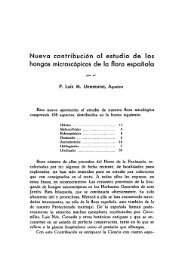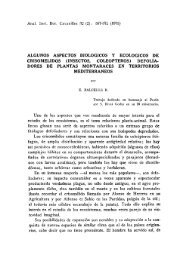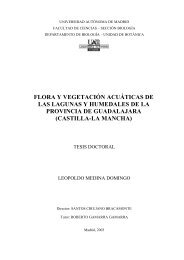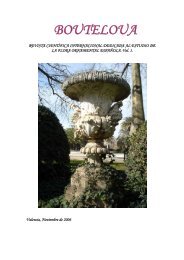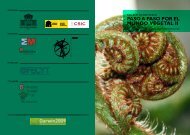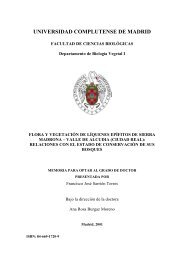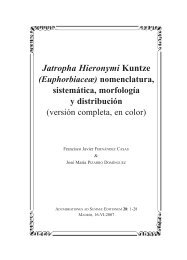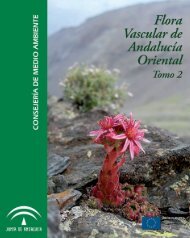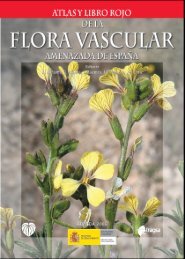Folia Botanica Extremadurensis, vol. 5 (2011) - Biblioteca digital del ...
Folia Botanica Extremadurensis, vol. 5 (2011) - Biblioteca digital del ...
Folia Botanica Extremadurensis, vol. 5 (2011) - Biblioteca digital del ...
- No tags were found...
You also want an ePaper? Increase the reach of your titles
YUMPU automatically turns print PDFs into web optimized ePapers that Google loves.
Nectaries of Gagea elliptica (A.Terrac.) Prain (Liliaceae)from Extremadura (Spain)Nectaries, frequent structures of the entomophilies plants, are nectar glands atdifferent flowers sites. They are the main attractive resources to insects and the pollinationprocess. The nectaries can are extrafloral or floral, dependent of the position. They arefrequently extrafloral nectaries, because many plants use the attractive nectar production fordifferent process, such as: fruit and seed dispersion, control diseases and the pollination supportin external floral exudates (Bernar<strong>del</strong>lo, 2007; Leins, & Erbar, 2010).We are interested in the study of the floral nectaries in monocot group, and specificallyin the Liliaceae family, because the PhD degree of the staring author of this paper, is relatedwith the systematic of the Gagea Salisb. genus from Extremadura (Spain). The species studiedwas Gagea elliptica (A.Terrac.) Prain, an endemic taxon from Southern and Centre of IberianPeninsula.Although there are previous data about the presence of nectaries in Gagea Salisb., andother genus in the Liliaceae family, such as Lilium L., have nectaries on upper site of the tepals(Leins & Erbar, 2010), no previous works (research, surveys...) about the presence (o existence)of nectaries in Gagea elliptica (A.Terrac.) Prain, were found. This data leads to study deeplynectaries G. elliptica, as a starting point in the taxonomy revision of the genus fromExtremadura (Spain).Material and MethodsPrevious to insert the results of the study, is necessary to show the support referencesof nomenclature used in this contributions: Bernar<strong>del</strong>lo (2007) and Schmid (1988) (nectarytypes), Nepi (2007) (ultrastructure and anatomical characteristics), and Blüthgen & al. (2003)(methodology of observation and study).The study is focused in taxa with wide distribution in Extremadura region: Gageaelliptica (A.Terrac.) Prain (Appendix 1).The plant material was collected, fixed by glutaraldehyde 2% and conserved in 70%ethanol. Samples were sequentially transferred into 100% ethanol and coated with goldpalladiumto scanning electron microscopy (SEM: EVO, LS10 Carl Zeiss Electron Microscopy,BSD1, 300-1000x, 8kV). To prepare the anatomical sections, materials were embedded inhistorresin® (Leica Mycrosystem) (Igersheim, 1993), and then observed in optical microscopeLeica DMRB. The study was carried out in the Biodiversity Laboratory of La Orden ResearchCenter (Badajoz).Results and discussionResults show a typical floral nectary insert between the base of the tepal and near tothe stamen filament insertion, it`s a perigonal or tepal nectar, classified as typeextrastaminal nectary (Schmid, R. 1988) (see Lamina 1 and 2). Also the study of theultrastructure revealed one nectary parenchyma type. The structures of nectaries observedare unicellular epidermis with pluricellular parenchyma, and different cellular morphology (seeLamina 1). The cells are round-quadrangular to ovate morphology, and have a high nectarproduction (Nepi, 2007). At the contact point with the nectary parenchyma we can observe onesubnectary parenchyma with large cells, and null to low nectar production (Durkee, 1982,1983) (Figure 1).The existence of extrafloral nectaries has ecological, e<strong>vol</strong>utionary and taxonomicimportance in group‘s plants. Some authors show the taxonomic and e<strong>vol</strong>utionary value of floralnectaries in classification of many angiosperm groups, and specifically, in monocots groups,where nectaries have importance in systematic and e<strong>vol</strong>ution (Blüthgen & Reifenrath, 2003;Bernar<strong>del</strong>lo, 2007), where tepal nectaries are relatively rare. These are frequent in Liliales andadopt various forms in this order (Bernar<strong>del</strong>lo, 2007).In other genus, in Liliaceae, the reproductive strategies and floral rewards, such asnectaries, are wi<strong>del</strong>y known (Zimmermann, 1932; Vaikos & Pai, 1982; Vaikos & al., 1989;95



